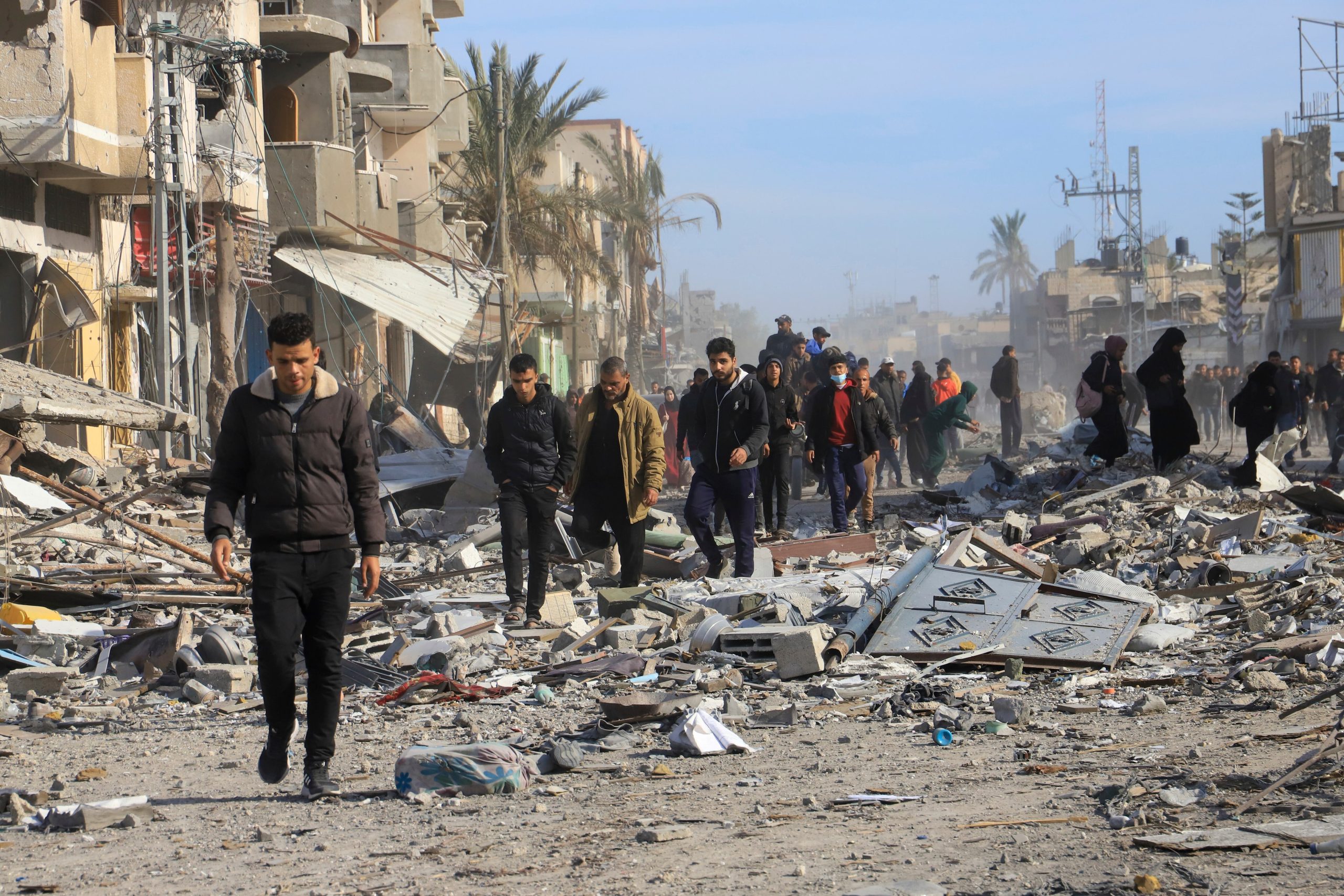Gaza Strip, Khan Younis Palestinians in the war-torn Gaza Strip started returning to the ruins of the houses they had fled during the 15-month conflict on Sunday, even before the ceasefire agreement between Israel and Hamas was finalized.
In the vast tent city of Muwasi, located just north of the southern border of the strip with Egypt, Majida Abu Jarad quickly packed the belongings of her family’s tent.
They were forced to leave their home in Beit Hanoun, a community in northern Gaza, where they used to congregate on the roof or around the kitchen table on summer evenings as the aroma of roses and jasmine filled the air, during the beginning of the conflict.
As a result of repeated evacuation orders from the Israeli military, Abu Jarad, her husband, and their six kids have been trekking the whole length of the Gaza Strip for the past year. The house from those happy recollections is no longer there.
She claimed that they had run away seven times, and each time their life had become increasingly unrecognizable as they slept on the street, in a large tent camp, or crammed into a school classroom with strangers in search of water.
The family is currently getting ready to start the journey back home, or to whatever is left of it, in order to meet up with family members who have stayed in the north.
Abu Jarad remarked, “We started packing our bags and deciding what we would take as soon as they said that the truce would start on Sunday, not caring that we would still be living in tents.”
On October 7, 2023, Hamas-led militants launched an offensive on southern Israel, killing around 1,200 people—mostly civilians—and kidnapping about 250 more, sparking the start of the Gaza War. At least one-third of the 100 hostages who are still inside Gaza are thought to be dead.
The Gaza Health Ministry reports that Israel’s offensive has killed over 46,000 Palestinians in Gaza, with over half of them being women and children. The ministry does not specify the number of combatants killed. According to the report, more than 110,000 Palestinians have been injured. Without any proof, the Israeli military claims to have killed more than 17,000 militants.
Large areas of Gaza have been leveled by the Israeli military’s shelling, and 1.9 million of the 2.3 million people living there have been forced to leave.
Many Palestinians started walking through the debris to go to their houses even before the truce was formally declared, with some carrying their things on donkey carts and others walking on foot as tank bombardment persisted through the night and into the morning.
According to Mohamed Mahdi, a father of two and displaced Palestinian, they are going back to recover their loved ones who are beneath the debris. A few months ago, he was compelled to abandon his three-story house in the southeast Zaytoun district of Gaza City.
Walking through the debris on Sunday morning, Mahdi made it to his house from western Gaza. He claimed that when driving through Gaza City, he witnessed the Hamas-run police force assisting residents in getting back to their houses.
He claimed that many were celebrating despite the enormous extent of the damage and the hazy outlook for reconstruction. They’re content. They began to remove the debris from their homes and clean up the streets. They have been waiting for this moment for fifteen months.
48-year-old Um Saber, a mother of six and widow, went back to her hometown of Beit Lahiya. For safety reasons, she requested to be known only by her honorific, which means “mother of Saber.”
She added over the phone that when walking home, her family had discovered dead in the street, some of which seemed to have been there for weeks.
According to her, they arrived in Beit Lahiya to find their house and a large portion of the neighborhood in ruins. Some relatives started searching for their loved ones right once by sifting through the wreckage. Others started attempting to make space so they could pitch tents.
According to Um Saber, she also discovered the Kamal Adwan Hospital in the region in utter ruin.
“It’s not a hospital anymore,” she said. Everything was destroyed by them.
Israeli forces conducting an attack against Hamas members in northern Gaza, which is mainly isolated, have struck the hospital many times in the last three months, claiming that the fighters have reassembled.
Hospital administrators have refuted military claims that Hamas militants operate inside Kamal Adwan.
Residents of Rafah, a city in southern Gaza that served as a center for displaced families escaping Israel’s shelling elsewhere in the Palestinian enclave, returned to find the city completely destroyed. Among the debris of homes and the streets, some discovered human remains.
The scene is beyond description. As he and his brother inspected his family’s home in the city’s Salam district, Mohamed Abu Taha, a native of Rafah, told The Associated Press, “It’s like you see a Hollywood horror movie.” Skulls and other body parts, human remains, and flattened homes were found among the debris and on the street.
He posted video of what he claimed to be his family’s home—piles of debris. How they demolished our house is something I’d like to know.
The returns coincide with impending doubts about who will run the enclave, how it will be rebuilt, and whether the ceasefire agreement will result in more than a brief halt to the combat.
Not every family will be able to go back home right away. The agreement states that starting seven days into the ceasefire, returning displaced individuals will only be permitted to travel from south to north across the Netzarim corridor.
Additionally, individuals who do return might have to wait a long time to restore their homes.
According to the UN, if Israel continues to impose a siege on Gaza, rehabilitation might take more than 350 years. Last month, the United Nations assessed that approximately 245,000 homes and 69% of Gaza’s structures were destroyed or damaged based on satellite data. It would take more than 15 years to remove the debris with more than 100 vehicles operating full-time.
However, the instant relief outweighed future anxieties for many families.
“The difference is that the bleeding will stop, the fear will stop, and we will sleep reassured,” Abu Jarad stated, adding that we would still be in a tent.
Magdy was in Cairo reporting. This report is written by Abby Sewell of the Associated Press in Beirut.



